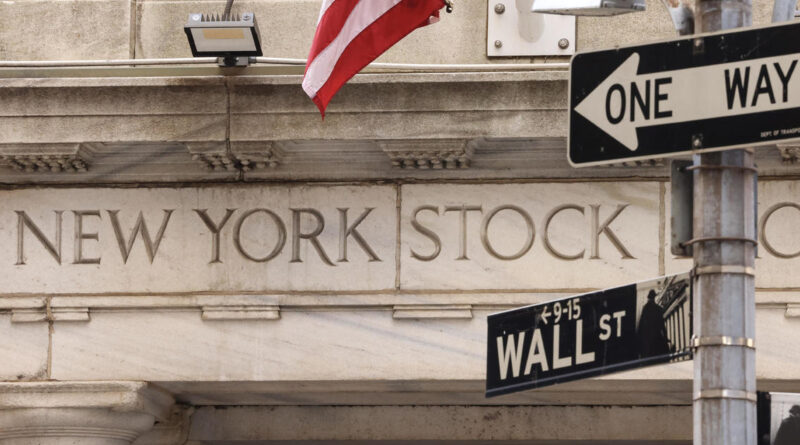Wall Street slumps, putting stocks on track for their worst day in nearly a month
U.S. stocks are slumping Tuesday following a disappointingly weak start to a week full of updates on the economy.
The S&P 500 was 1.9%, or 108 points, lower in afternoon trading and on track for its worst day in nearly a month, coming off a winning week that had carried it to the cusp of its all-time high. The Dow Jones Industrial Average was down 560 points, or 1.4%, from its own record set on Friday before Monday’s Labor Day holiday. The Nasdaq composite was 3.1% lower, as of 2:45 a.m. Eastern time.
Treasury yields were also sinking in the bond market after a report showed U.S. manufacturing shrank again in August, as it continues to wilt under the weight of high interest rates. Manufacturing has been contracting for most of the past two years, and its performance for August was worse than economists expected.
“Demand remains subdued, as companies show an unwillingness to invest in capital and inventory due to current federal monetary policy and election uncertainty,” said Timothy Fiore, chair of the Institute for Supply Management’s manufacturing business survey committee.
Worries about a slowing U.S. economy helped send stocks on a scary summertime swoon early last month, but financial markets later rebounded on hopes that the Federal Reserve could pull off a perfect landing for the economy. After jacking its main interest rate to a two-decade high to beat high inflation, the Fed looks set to ease interest rates later this month in hopes of easing conditions for the economy and avoiding a recession.
September volatility
As analysts at UBS point out, volatility is typical in the month of September, a time when “investors will parse a range of data releases to gauge the state of the U.S. economy – especially Friday’s jobs data – ahead of a widely expected interest rate cut by the Fed.”
Still analysts at UBS are keeping a positive outlook and advise investors to do the same.
“We recommend investors keep a long-term perspective with regard to their financial goals and focus on quality companies in their equity holdings. Investors should also ensure their portfolios are well diversified across asset classes, regions, and sectors, including allocations to alternatives and hedges such as gold. Structured strategies offer another way to manage potential volatility ahead,” Solita Marcelli, chief investment officer Americas at UBS Global Wealth Management said in a note.
Other reports later this week that could show how much help the economy needs, including updates on the number of job openings U.S. employers were advertising at the end of July and how strong U.S. services businesses grew last month. The week’s highlight will likely arrive on Friday, when a report will show how many jobs U.S. employers created during August.
The jobs report has once again become the main event for the stock market each month, taking over from updates on inflation, according to analysts at Bank of America. Many traders are anticipating the Fed will deliver a full percentage point of cuts to interest rates this year, which is a “recession-sized” amount, Gonzalo Asis and other economists and strategists wrote in a BofA Global Research report.
U.S. Steel falls after Harris dings merger
On Wall Street, U.S. Steel fell 5.3% in its first trading after Vice President Kamala Harris said Monday she opposes the company’s planned sale to Japan’s Nippon Steel. The Democratic presidential nominee’s comments, which echo President Joe Biden’s position, came after Nippon Steel Corp. said last week it would spend an additional $1.3 billion to upgrade facilities in Pennsylvania and Indiana, on top of a previous $1.4 billion commitment.
Nippon Steel also reiterated that it expects the transaction to close by the end of this year, despite ongoing political and labor opposition.
Nvidia was the heaviest weight by far on the S&P 500 after falling 7.2%. Its stock has been struggling even after the chip company topped high expectations for its latest profit report. The subdued performance could bolster criticism that Nvidia’s and other Big Tech stocks simply soared too high amid Wall Street’s rush into artificial-intelligence technology.
Stocks of oil and gas companies also helped drag the market lower after the price of crude oil fell roughly 4% on worries about how much fuel the global economy will burn. A barrel of benchmark U.S. oil is almost back to $70 and down for the year so far after climbing above $85 in April. Exxon Mobil lost 2.3%, and ConocoPhillips dropped 3%.
Still, it wasn’t a complete washout on Wall Street. More than 1 in 3 stocks within the S&P 500 was climbing, led by those that tend to benefit the most from lower interest rates. That includes dividend-paying stocks, as well as companies whose profits are less closely tied to the ebbs and flows of the economy, such as utilities and makers of consumer staples.
In the bond market, the yield on the 10-year Treasury fell to 3.85% from 3.91% late Friday. That’s down from 4.70% in late April, a significant move for the bond market.





